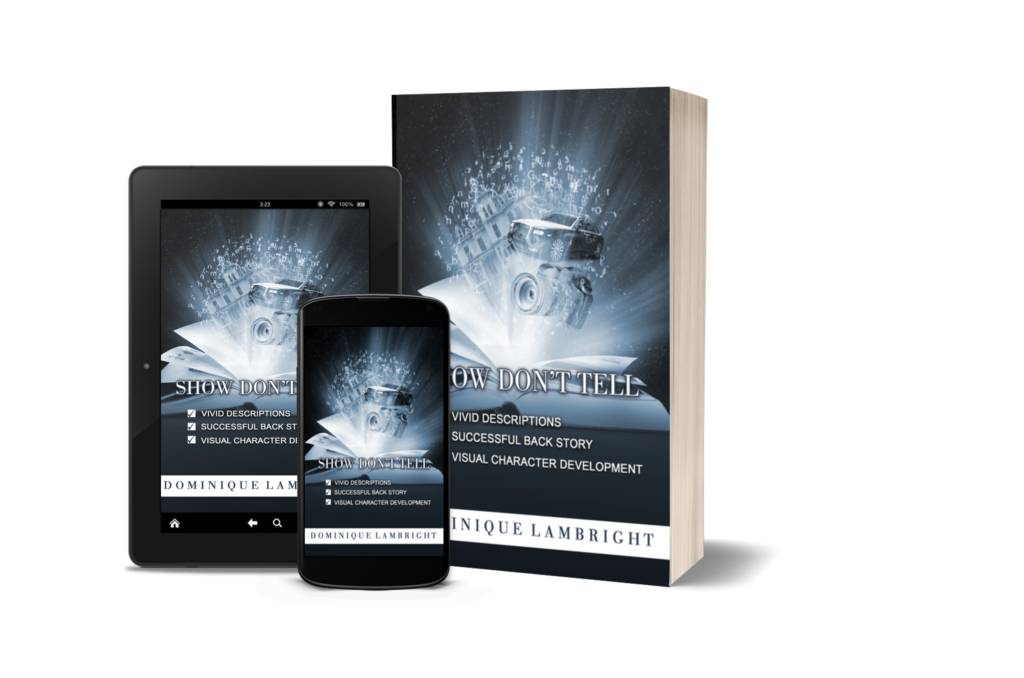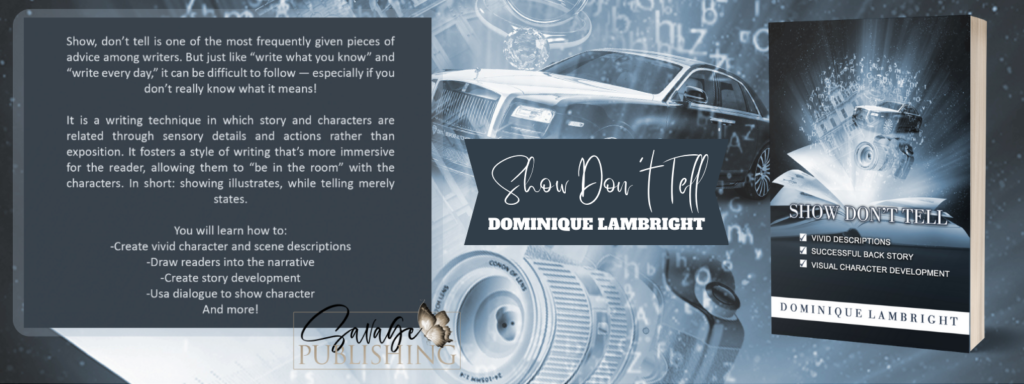Books, Characters, Sneak Peeks
Show Don’t Tell Sneak Peek
Synopsis:
Show, don’t tell is one of the most frequently given pieces of advice among writers. But just like “write what you know” and “write every day,” it can be difficult to follow – especially if you don’t really know what it means!
It is a writing technique in which story and characters are related through sensory details and actions rather than exposition. It fosters a style of writing that’s more immersive for the reader, allowing them to “be in the room” with the characters. In short: showing illustrates, while telling merely states.
You will learn how to:
-Create vivid character and scene descriptions
-Draw readers into the narrative
-Create story development
-Use dialogue to show character
And more!

Excerpt:
The Art of Showing: How to Turn Telling into Showing
Now that you know how to recognize telling and what it is and why it is important, we can examine the mechanics of showing. What follows are the nine most important guidelines for demonstrating:
Use the 5 Senses
To “show” in a story is to put the reader in the shoes of the point of view character and allow them to interact with the environment as the character does. Write from the point of view of your character, describing everything he sees, hears, smells, tastes, and feels. Use more than simply sight to capture your audience’s attention.
Example: I stuck my nose out of the car’s open window and breathed in the fresh pine scent. The cold air made my cheeks burn, and my eyes tear.
Use Strong, Dynamic Verbs
Use robust, dynamic verbs instead of weak, inert verbs to bring your text to life. Instead of just writing “she walked,” you may give us more of a sense of her gait by adding that she strutted, strode, trekked, or tiptoed. Look out for weak verbs like “to be,” “to have,” and “to have been,” and swap them out with more powerful verbs that give the reader a more vivid mental image.
Example: Telling: The man was thin and wore a coat that was too big for him.
Showing: His coat hung around his frame.
Verbs that can also weaken your writing are started to and began to.
Example: Weak verb: The woman started to shake.
Without the weak verb: The woman shook.
Or maybe even better: Fine tremors rushed through the
woman’s body.
However, moderation is still required. Sometimes, you may like for your characters to just stroll across the room, rather than swagger, trudge, or tiptoe. Use a weaker verb if the activity being described is not crucial. Use the more forceful verb to illustrate how your heroine is feeling as she walks, however, and you’ll create a more tense and exciting read.
Use Concrete Nouns
Be as precise as you can instead of using vague language. That is true not only for verbs but also for nouns. To paint the picture you desire in your readers’ imaginations, choose words that are specific and precise. You can save your readers the trouble of having your characters have breakfast by telling them they’re eating eggs and bacon instead. Show the readers a Great Dane drooling instead of informing them your protagonist has a dog.
Example: Telling: Tina lived in a big house.
Showing: Tina’s steps echoed across the foyer as she entered the mansion.
Break Activities into Smaller Parts
One way to make your writing more specific is to break up general tasks into smaller parts. Instead of saying that your main character is cleaning, show us that she is vacuuming and frowning when she finds a sock under the couch.
But don’t do too much. If the activity isn’t important, you can sum it up in a general way. But break it up if it shows something about the character, like how careful she is, or moves the story forward. If she finds drugs under her son’s bed instead of a sock, it might be more interesting to show the details than to just say that she was cleaning.
Use Figurative Language
Figurative language, like similes and metaphors, is one way to make your writing more vivid and help readers picture what you’re talking about. A simile is a figure of speech that compares two things by saying “like” or “as.” For example, “her hair shone like gold.” A metaphor is a more direct way to compare two things. For example, the company was like a gold mine.
Example:
Telling: Betty had callused palms.
Showing: Betty’s palms felt like sandpaper.
The best comparisons and metaphors always come from the background of the character. For instance, a character who thinks Betty’s palms feel like sandpaper must have felt sandpaper before. Maybe he or she is a carpenter or an artist who works with wood.
Someone who didn’t come from that kind of background would use a different example. But be careful not to do too much. If you use too many metaphors and similes, your writing will sound pretentious and overwritten. Metaphors and similes can also become overused, so try not to use the first thing that comes to mind.
Write in Real-Time
Use scenes to show how events develop over time. Don’t just tell your readers what occurred; show them. The usage of the past perfect tense, as in she had gone, is another red flag that you have abandoned writing in the present tense.
Of course, you don’t have to portray everything in real time; otherwise, your work would be filled with useless acts that have no purpose. In this chapter, I will explain how telling may be an effective method for omitting superfluous details. You should prioritize displaying pivotal sequences, such as those that advance the story or provide light on a character.
Use Dialogue
Dialogue is a great tool for bringing the story to life and showing the progression of events as they happen. At least, if you know what you’re doing, dialogue will always be visible. There will be further discussion of the differences between showing and telling in conversation in the next section.
Example: Showing: “Well, hello,” Tina drawled. “The view in here just got a lot better.”
Use Internal Monologue
Showing what your POV character is thinking can also help reveal her emotions without naming them.
Example: Telling: I was relieved when my workday ended.
Showing: Finally, the bell rang, announcing the end of my workday. Thank the Lord.
Focus on Actions & Reactions
The adage “actions speak louder than words” applies here. Readers may need more convincing than you giving them if you say your female protagonist is a cruel, bitter person. Displaying her cruel nature by having her kick a dog would undoubtedly resonate with your audience.
Authors should let readers discover characteristics of their characters on their own via the story’s events. You may learn a lot about the character by how they respond to the story’s events. By contrast, showing rather than telling allows your characters’ behaviors to demonstrate who they are.
Example 1: Telling: Tina was a loyal friend. She always helped out whenever one of her acquaintances or family members needed her.
That doesn’t seem like it belongs in a scene at all; it sounds more like one of the character sketches I’m making before beginning a new book. Instead than allowing the readers get to know Tina via her actions, the author just describes what she’s like.
Showing: “Come on.” Tina patted her shoulder. “Assembling the furniture won’t be that bad. You know what they say about many hands.” She picked up the screwdriver.
Example 2: Telling: Jake had always been a little clumsy.
Showing: When he reached out to pick up the saltshaker, he knocked over his wineglass.
EXERCISE #3:
Reread the opening of your current work in progress. Is there an opportunity to explain anything your character sees, hears, smells, tastes, or touches by using the five senses? Add a few lines of descriptive prose that focus on the senses to help immerse your readers in your story’s setting.
EXERCISE #4:
Is the opening scene lacking in dynamic verbs? Do you have many hads and was’, or not many at all? Do your protagonists stroll leisurely rather than slogging, or do they walk fast rather than jog? Try to find better verbs to replace the ones you’ve used so far.
EXERCISE #5:
Check out the first chapter. What kind of characteristics of yours have you described? Try to find phrases such, “Tina was… (a faithful friend)” or “Tina loved… (gossiping)”. Rewrite the scenario to illustrate the reader the character’s attributes via their actions if you’ve already told them.
Redundancies: Avoid telling what you’ve already shown
Another frequent flaw in the manuscripts I edit is repetition of information already presented in other parts of the text. Sometimes authors may add a tell after they have eloquently showed their readers something, as if they want to make sure they “got it.”
Example: Betty glanced down at the hand on her arm, her eyes flashing with anger.
Her furious expression and the accompanying “with rage” both make it clear that she is fuming. Eliminate the narrating. You should rephrase a line to demonstrate more powerfully if you aren’t certain that it will disclose the character’s feelings without telling.
Rewrite: Betty glanced down at the hand on her arm, her eyes flashing.
Or: Betty glared at the hand on her arm.
Example 2: Betty’s brow wrinkled. “I don’t know if that’s such a good idea.” She obviously wasn’t convinced.
Her expression and words indicate that she is still not persuaded; hence, the final line is unnecessary. Make an effort to avoid repeating information that has previously been shown. Have faith in your ability to demonstrate and in the ability of your readers to infer meaning from that demonstration.
Rewrite: Betty’s brow wrinkled. “I don’t know if that’s such a good idea.”
EXERCISE #6:
Take another look at the opening scene. Have you made any claims that you have demonstrated? If this is the case, the showing should be allowed to take precedence over the telling.
Coming Soon to the book shop!



